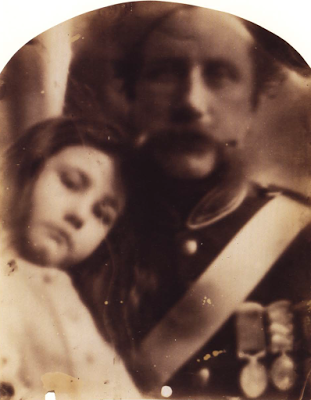
Kate and Thomas Keown (1864) Julia Margaret Cameron
Once upon a time there was a brave solider called Thomas James Keown. He was born in Plymouth, Devon, in 1823. Just before his 17th birthday, Thomas joined the Royal Artillery as a driver. As this was 1840, it obviously didn't mean motor vehicles, but it meant he was the equivalent of a 'private' and his job was to drive the horses who pulled the guns. He fought in the Crimean War from 1853, under Colonel Edward Charles Warde CB, who had known Thomas since the beginning of his military career. It was under Warde's command that Thomas volunteered and accompanied a spiking party (disabling the enemy guns by means of driving metal spikes into the touchholes, or other damaging things, very dangerous work) in the assault on the Redan in June of 1855. For his 'long and meritorious services and good conduct', he was awarded a silver medal and £10 (around £850 in today's money). The Colonel arranged for his family to drive Mrs Keown up to the Fort to see her husband decorated, and the Colonel 'shook him warmly by the hand and expressed a wish that he might long live to wear it.'
The Attack on the Redan (1899) Robert Hillingford
Thomas was wounded as a result of his action, at the Siege of Sebastopol, probably in the Autumn of 1855 and was sent back to England to recover. Seeing as he had spent so much of his life abroad, it might be that it was on his return to England he met the woman he would marry just a year later. Sarah Hendry was the daughter of a Gunner in the Royal Artillery, from Woolwich in Kent and the couple were married in Plumstead, Kent in 1856. When Thomas had recovered, he was promoted to Master Gunner and placed in charge of Redoubt Fort in Freshwater. Their first child Kate was born just 10 months after their marriage.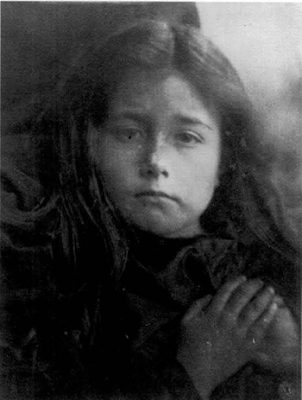
Kate Keown (1864)
Kate was followed in fairly quick succession by Louisa (1858), Elizabeth (1860), Alice (1861), Percy (1864) and Mabel (1868). In many ways the Keown family, although a generation younger, established themselves at Freshwater around the same time as the Camerons, less than half a mile away at Dimbola Lodge. When Julia Margaret Cameron's eyes turned to potential models for her photographic ventures she didn't have to look far...
Elizabeth Keown, Annie Philpot and Unknown Child (1864)
Although not the subject of her first image (that honor goes to Annie Philpot), the Keown sisters, Kate, Elizabeth, Louisa and Alice were perfectly placed to appear in her first year of photographs. Four year old Elizabeth appeared with Annie Philpot in the above image, both Alice and Elizabeth appeared with Mary Hillier in Long Suffering and Kate and Louisa appeared in solo studies.
Long Suffering (Elizabeth Keown, Mary Hillier, Alice Keown)
Percy joined the family in the summer of 1864 and became the baby in many Biblical scenes...
La Madonna Riposata, Resting in Hope (Mary Hillier, Percy Keown) (1864)
Interestingly, as far as I can tell, Mabel, born in 1868, was never the subject of a Cameron photograph, but this might be for many reasons. By that point, Cameron's aesthetic was moving away from babies and Madonna scenes, growing with her subjects in many ways. Also, after 1865, Percy doesn't appear very much, replaced by Cameron's grandson Archie. Louisa also doesn't appear again, but for a difference reason.
'Loulou' Louisa Keown (1864)
We only have potentially one Cameron photograph of little Louisa Keown. Six years old and blurred, her tiny face gazes out at us. In the Spring of 1865, Louisa died and was buried at All Saints in Freshwater, eventually alongside Lady Tennyson, Prinsep family members and Mary Hillier. It is a complicated matter, Victorians, death and photography, because convention makes us believe that the Victorians were so keen to have their loved ones recorded on film that they would prop them up, post-mortem, for the chance of an image. With just such opportunities just down the road, it is interesting that Mabel Keown does not seem to appear in any of Mrs Cameron's photographs, even though her other sisters continued their modelling careers. Possibly it was too painful for Louisa's parents to see their lost child frozen in an image. After all, how can we explain Cameron's recording of the death of adopted daughter Adeline Clogstoun but not of her own beloved daughter, Julia Norman, who died two years later?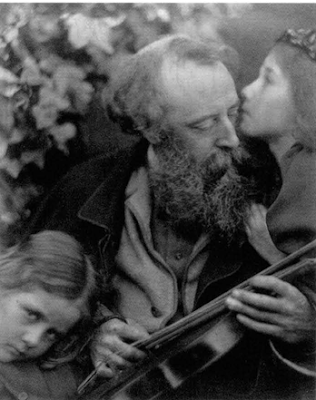
The Whisper of the Muse (Elizabeth, G F Watts, Kate) (1865)
What we are left with are Elizabeth, Kate and Alice as they grow up. Seemingly the three sisters continued to pose through the loss of their sister, but in reality there might have been a gap of a year or more between their sittings, but after the death of Louisa, the three little muses suddenly seem to mature. Possibly as a response to this Cameron entitled one dark shot of Kate Keown Grief in 1866. It is easy to read the effect of the bereavement on them in their suddenly more adult faces but equally the girls were growing rapidly towards young adulthood.
Minstrel Group (Mary Ryan, Kate, Elizabeth) (1866)
Alice doesn't appear as often as her sisters, but makes a very striking appearance in a later picture, as a young novice by the side of the disgraced Queen Guinevere, played by Mrs Hardinge.
The Little Novice with Queen Guinevere in the Holy House at Almesbury (1874)

Study of Cenci (1868)
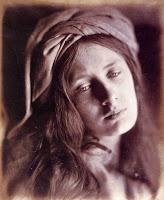
Kate's face changes so subtly between years but more than any other model, she evolves before our eyes in the photographs. At 13, she posed for The Snowdrop, 10 years before Rossetti used the same device on a portrait of Jane Morris entitled Blanzifiore. The same year she is pictured in possibly the most elegant and striking of her pictures, simply entitled Group where she leans against Mary Hillier, who gazes away in noble profile.

The Snowdrop (1870-2)

Group (1870)
The same year as her younger sister posed as a nun, 17 year old Kate posed for one of her last images, the very adult The Twilight Hour, with an unknown man, one of the 'courting' photographs of Cameron's later years.
The Twilight Hour (1874)
Kate has grown from the infant innocently kissing her sisters and other local children to a woman in the midst of a failed romance (the theme of The Twilight Hour comes from Adam Bede by George Eliot). She is one of the few models who manages to fill both the roles Cameron desired in her photographs - cherubic child and beautiful young woman.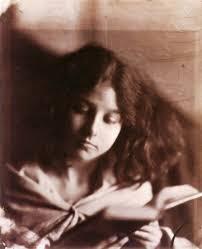
Kate Keown Reading (1867)
After the Camerons moved away, life went on for the Keowns. Kate married a granite merchant from Cornwall, Bernard Freeman, and ended up living back in the West Country where her father had come from. They had no children but by the 1911 census the couple were living in a property called 'Beachview' with a cook and a housemaid. She died in 1922, aged 65.
Paul and Virginia (Freddy Gould and Elizabeth) (1865)
Elizabeth, or 'Topsy' as she was also known, married in 1879 to an army schoolmaster called William Douglas. She became a colonial wife, and a mother to two daughters, born in India. When the family retired back to Surrey they played host to brother Percy for a short while. She outlived all but one of her siblings, dying in 1952, aged 92.

Light and Love (Percy, Mary Hillier) (1865)
Percy became third mate on the SS Tartar, a Royal Mail steam ship that seems to have traveled swiftly between South Africa and Southampton. He received his second and first mate certificate by 1887 and traveled as far as Australia. By the 1901 census, however, Percy is living with sister Elizabeth, at 'Pendennis' in Weybridge, Surrey. On the far right of the form one word starkly presents his fortunes - 'paralysed'. I can't begin to imagine what exactly befell him but a few months later he was dead, aged 36.
Hosanna (Alice, Marys Kellaway, Ryan and Hillier) (1865)
Alice married Henry Johnson, a surgeon (and son of a surgeon). Henry was a military man, holding the rank of Captain and decorated for his work in India while his wife and child remained at his family home in Hampshire. They joined him in Africa for the 1911 census but Henry died in 1918 in South Africa leaving his wife less than £2,000. Alice and daughter Gladys returned to England and lived long lives, Alice outliving her siblings to die in 1959, aged 98.
The Turtle Doves (Alice and Elizabeth) (1864)
It seems incredible to think that little Alice almost lived long enough to see a century pass since her first image by Mrs Cameron. She also almost lived long enough to see the 1960s and the whole rediscovery of Victorian art where images of utter innocence like the one above would be viewed with suspicion or cynicism of such saccharine. It is tempting to think of the halcyon days of Freshwater as another age, far removed from ours but sometimes the Victorian age is so close to us, it is almost possible to hear it whisper...
